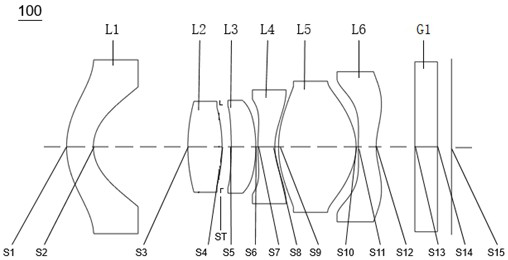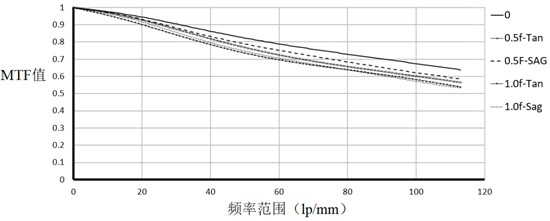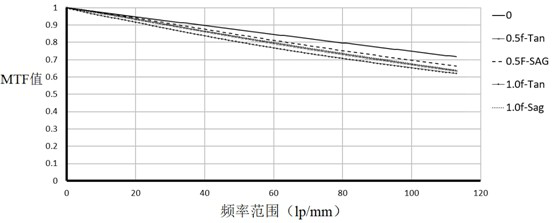Infrared confocal lens
An infrared confocal lens technology, applied in the field of infrared confocal lens, achieves the effects of smooth light, miniaturization, and low manufacturing cost
- Summary
- Abstract
- Description
- Claims
- Application Information
AI Technical Summary
Problems solved by technology
Method used
Image
Examples
no. 1 example
[0069] see figure 1 , is a schematic diagram of the structure of the infrared confocal lens 100 provided in the first embodiment of the present invention. The infrared confocal lens 100 includes in sequence from the object side to the imaging surface along the optical axis: a first lens L1, a second lens L2, and a stop ST , the third lens L3, the fourth lens L4, the fifth lens L5, the sixth lens L6, and the filter G1.
[0070] The first lens L1 has negative refractive power, the object side S1 of the first lens is a convex surface, and the image side S2 of the first lens is a concave surface;
[0071] The second lens L2 has a positive refractive power, and both the object side S3 and the image side S4 of the second lens are convex;
[0072] The third lens L3 has positive refractive power, the object side S5 of the third lens is concave, and the image side S6 of the third lens is convex;
[0073] The fourth lens L4 has negative refractive power, the object side S7 of the four...
no. 2 example
[0087] see Figure 4 , shows a schematic diagram of the structure of the infrared confocal lens 200 provided in this embodiment, the infrared confocal lens 200 in this embodiment and the infrared confocal lens 100 in the first embodiment have roughly the same surface concave and convex, different The difference is that the object side S5 of the third lens L3 is convex at the near optical axis, and there are differences in the parameters such as the radius of curvature and thickness of each lens. Specifically, relevant parameters of each lens of the infrared confocal lens 200 in this embodiment are shown in Table 3.
[0088] table 3
[0089]
[0090] The relevant parameters of the aspheric lens of the infrared confocal lens 200 in this embodiment are shown in Table 4.
[0091] Table 4
[0092]
[0093] The MTF curves of the infrared confocal lens 200 provided in this embodiment under the spectral conditions of 435nm-650nm (visible light) and 900nm-1100nm (infrared ligh...
no. 3 example
[0095] see Figure 7 , shows a schematic diagram of the structure of the infrared confocal lens 300 provided in this embodiment, the infrared confocal lens 300 in the present embodiment and the infrared confocal lens 100 in the first embodiment have roughly the same concave-convex surface shape, different The difference is that the object side S5 of the third lens L3 is convex, and the object side S7 of the fourth lens L4 is concave at the near optical axis, and there are differences in parameters such as the radius of curvature and thickness of each lens. Specifically, relevant parameters of each lens of the infrared confocal lens 300 in this embodiment are shown in Table 5.
[0096] table 5
[0097]
[0098]The relevant parameters of the aspheric lens of the infrared confocal lens 300 in this embodiment are shown in Table 6.
[0099] Table 6
[0100]
[0101] The vertical axis chromatic aberration and axial chromatic aberration of the infrared confocal lens 300 prov...
PUM
 Login to View More
Login to View More Abstract
Description
Claims
Application Information
 Login to View More
Login to View More - R&D
- Intellectual Property
- Life Sciences
- Materials
- Tech Scout
- Unparalleled Data Quality
- Higher Quality Content
- 60% Fewer Hallucinations
Browse by: Latest US Patents, China's latest patents, Technical Efficacy Thesaurus, Application Domain, Technology Topic, Popular Technical Reports.
© 2025 PatSnap. All rights reserved.Legal|Privacy policy|Modern Slavery Act Transparency Statement|Sitemap|About US| Contact US: help@patsnap.com



